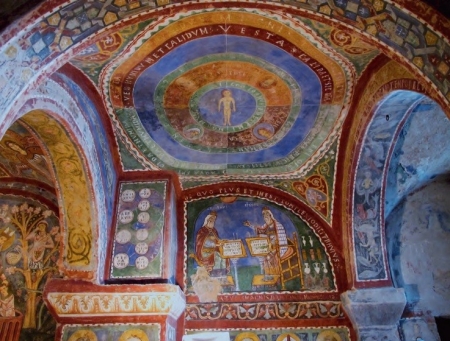This important artistic development occurred in the unexpected cultural-historical context of the thirteenth-century papal court. Until now it has been assumed that the thematization of temporal knowledge in the visual arts emerged instead in the courts of secular rulers and the thriving communes and university towns of Siena, Florence, and Padua. According to this conventional narrative, artistic innovation in Rome was stifled by the conservative attitude of popes and cardinals who remained content to rebuild their basilicas in the image of the early Christian originals and to repaint these basilicas with new versions of the same pictures of saints and Biblical stories that had originally adorned them. My dissertation overturns this art-historical narrative by foregrounding the pivotal role Roman artists and their curial sponsors played in creating what might be described as a new painting of knowledge.
Recent scholarship has demonstrated the ways in which the papal court cultivated interests in the natural sciences with greater intensity in the thirteenth century than in earlier epochs. In this process, the curia became one of the most important arenas for the translation and dissemination of Greek and Arabic texts, as well as for the production of new scientific works in the fields of alchemy, optics, medicine, and astronomy. Popes and cardinals of the thirteenth century considered their courts rivals to those of rulers elsewhere in the Mediterranean world, such as Frederick II in Sicily and Alfonso of Castile in Spain.
The monumental fresco cycle was exceptionally equipped to represent, address, and analyze the structural changes in thirteenth-century knowledge. The mural painter could integrate new knowledge into a revised image of the world, and, through a variety of pictorial devices, such as the use of color and framing, could create the effect of a unified whole. In this process, and for the first time in the history of medieval art, complex diagrams and other scientific imagery were transposed from the realm of manuscript illumination to that of monumental wall painting. The representation of the microcosm and the syzygy diagram of the elements in the Anagni crypt are important examples of this transformation.
Perhaps more important than the pictorial devices available to the muralist, in mural painting the figured surface is inseparable from the architectural fabric in which it is embedded, and this quality endows the medium with unique spatial characteristics. In both Santi Quattro Coronati and Anagni the painters took full advantage of the mural’s possibilities to create three-dimensional, inhabitable images. Both fresco cycles therefore produce a viewing experience that is opposed to that produced by an illuminated manuscript. Whereas the manuscript might rest in the hands of its viewer, the fresco cycle wraps itself around the beholding subject, effectively reversing the phenomenological terms of viewer reception.
The mural cycles in Santi Quattro Coronati and the Anagni crypt mark a fundamental shift in the history of medieval art; a transformation of monumental painting from the customary icons and narratives toward a new painting of encyclopedic knowledge. In the analysis of this development, my dissertation asks which cultural circumstances made possible, and perhaps even required, the emergence of a new art form as well as what deeper religious and philosophical concerns motivated the gathering and affirmation of the world’s knowledge in a single image. The guiding thesis of the project is that the encyclopedic fresco cycle reshaped the relationship of art to knowledge by responding to the period’s wide-reaching exchange of texts, artifacts, and technology in the Mediterranean region. I argue that the crypt in Anagni and the painted palace in Santi Quattro Coronati respond to their historical circumstances of epistemic change and take on an important heuristic function. Both cycles furnished virtual models of the world, and in this capacity they could operate as arenas in which competing models of knowledge could be compared and contrasted.
Members' Research Report Archive
The Image of the World in Thirteenth-Century Rome
Marius Bratsberg Hauknes [Princeton University]
Twenty-Four-Month Chester Dale Fellow, 2011–2013
The early thirteenth-century fresco cycles in the cardinal’s palace at Santi Quattro Coronati in Rome and the crypt of the cathedral of Anagni comprise dense assemblages of knowledge in visual form. In addition to their encyclopedic subject matter—zodiacs, constellations, the months, vices and virtues, the liberal arts, the microcosm—the two cycles share a visual language that employs personification, allegory, and diagrams. But the most striking common feature of these fresco programs is their attempt to represent pictorially all fields of available knowledge in a comprehensive and systematic way. Collectively, the two mural works

Anagni cathedral, crypt, frescoes depicting the microcosm in the vault, a syzygy diagram of the elements on the pillar, and a conversation between Hippocrates and Galen in the lunette, c. 1230–1250. Author photograph